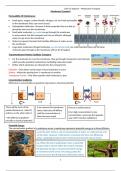Cells To Systems - Membrane Transport
Membrane Transport
Permeability Of Membranes:
Small gases, oxygen, carbon dioxide, nitrogen, etc are freely permeable
to the membrane (they can travel across)
Hydrophobic Molecules - Because of their properties they are able to
penetrate and cross the membranes
Small polar molecules e.g. water can go through the membrane
to some extent, but this transport won’t be as efficient, although
water can go across the membrane
Water has special channels that facilitate diffusion of water across
the membrane
Large polar molecules/charged molecules e.g. ions/amino acids are really selective (does not let these
molecules pass through as the membrane will not let it happen)
Transmembrane Proteins Facilitate Transport:
For the molecules to cross the membrane, they go through transporters and channels
which provide specificity (selectivity), facilitating molecules inside
Define which substrates are allowed into the compartment
Channels - Only allows certain types of ions/substrates to cross
Solutes - Molecules passing from 1 membrane to another
Transporter/Carrier - Only allow specific small molecules to pass
Concentration Gradients:
Difference in concentration (a gradient) represents a chemical potential
There will be more of the If we remove this membrane, Process is unidirectional
solute/chemical on 1 side (C) these molecules will diffuse
and less on the other side (c) From high concentration to low
until the concentration of
concentration, cannot go the opposite
them becomes equal
= this difference/gradient way until it reaches equilibrium
provides a chemical potential
Potential Energy:
The concentration gradient of a substance across a membrane represents potential energy as it drives diffusion
e.g In this dam, there is a lot of concentration of water on 1 side and not a lot
on the other. However, if the barrier is removed, the force can diffuse/go
down = potential energy has been restored and released and can travel
e.g. When the bow is pulled back, there is potential
energy which is stored. When the string is released,
the potential energy is converted to kinetic energy
in movement of the arrow. The string pushes the
arrow out and is the driving force behind the motion
1





